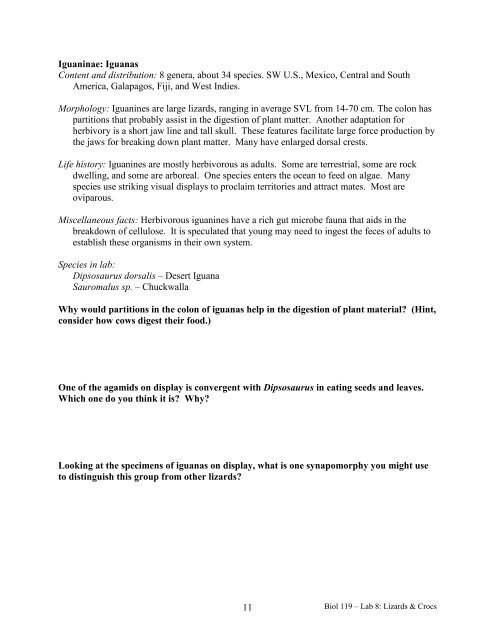Biol 119 – Herpetology Lab 8: Lizard and ... - Clark University
Biol 119 – Herpetology Lab 8: Lizard and ... - Clark University
Biol 119 – Herpetology Lab 8: Lizard and ... - Clark University
Create successful ePaper yourself
Turn your PDF publications into a flip-book with our unique Google optimized e-Paper software.
Iguaninae: Iguanas<br />
Content <strong>and</strong> distribution: 8 genera, about 34 species. SW U.S., Mexico, Central <strong>and</strong> South<br />
America, Galapagos, Fiji, <strong>and</strong> West Indies.<br />
Morphology: Iguanines are large lizards, ranging in average SVL from 14-70 cm. The colon has<br />
partitions that probably assist in the digestion of plant matter. Another adaptation for<br />
herbivory is a short jaw line <strong>and</strong> tall skull. These features facilitate large force production by<br />
the jaws for breaking down plant matter. Many have enlarged dorsal crests.<br />
Life history: Iguanines are mostly herbivorous as adults. Some are terrestrial, some are rock<br />
dwelling, <strong>and</strong> some are arboreal. One species enters the ocean to feed on algae. Many<br />
species use striking visual displays to proclaim territories <strong>and</strong> attract mates. Most are<br />
oviparous.<br />
Miscellaneous facts: Herbivorous iguanines have a rich gut microbe fauna that aids in the<br />
breakdown of cellulose. It is speculated that young may need to ingest the feces of adults to<br />
establish these organisms in their own system.<br />
Species in lab:<br />
Dipsosaurus dorsalis <strong>–</strong> Desert Iguana<br />
Sauromalus sp. <strong>–</strong> Chuckwalla<br />
Why would partitions in the colon of iguanas help in the digestion of plant material? (Hint,<br />
consider how cows digest their food.)<br />
One of the agamids on display is convergent with Dipsosaurus in eating seeds <strong>and</strong> leaves.<br />
Which one do you think it is? Why?<br />
Looking at the specimens of iguanas on display, what is one synapomorphy you might use<br />
to distinguish this group from other lizards?<br />
11<br />
<strong>Biol</strong> <strong>119</strong> <strong>–</strong> <strong>Lab</strong> 8: <strong>Lizard</strong>s & Crocs
















